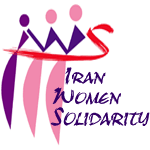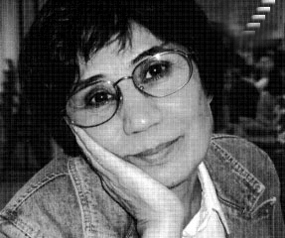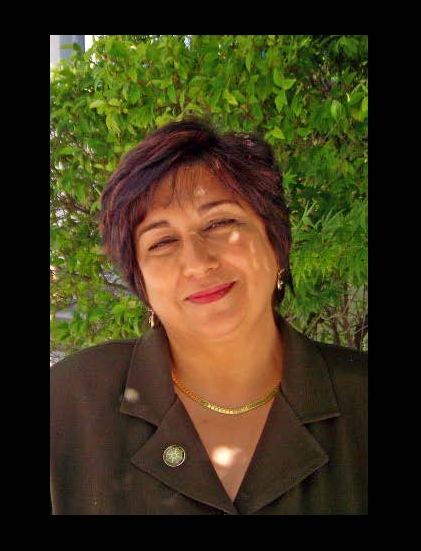Shadi Sadr, Iranian feminist and human rights activist, working as lawyer and journalist was released from prison on Tuesday on bail the equivalent of over 36.000 Euros. That she was released together with 140 others who were arrested recently has been interpreted as a response to growing criticism, even by some clerics, of the violent methods employed by the regime. A conservative estimate gives the number of those still in jail as ten times this number.
Shadi Sadr was kidnapped on a street in Tehran on July 17. Two civil clothes men who refused to identify themselves forced her into their car. As no detention order was presented she resisted arrest with help from her companions. She was beaten up with baton blows and her overall and head scarf were torn away from her before she was taken away. It emerged unofficially that she was being kept in an isolation ward of Evin prison. One reason for her arrest can be that in her latest article, she presents what amounts to a blue print for how the women’s movement should relate to the overall political movement for change. For any one interested in what is going below the surface in Iran at the moment it is essential reading.
I met Shadi in mid June this year in Hanover in an international conference of Iranian women where she gave a fascinating lecture on the intricacies of the question of compulsory veil in Iran. Among her numerous activities and writings that have brought her international recognition—including the Ida B Wells award for bravery in journalism—is her work as the head of the organisation against stoning. Most of the victims of this punishment are women accused of adultery.
Her latest article, “What Is to Be done?”, reflecting her ability to formulate a clear-sighted strategy for the women’s movement, distinguishes Shadi as a formidable adversary to the patriarchal system that is the backbone of the religious dictatorship in Iran.
In the Western media interpretation of the presidential elections and its aftermath what is happening in Iran is rivalry between political factions within the religious power elite. But, irrespective of differences of interest and opinion, none of the factions have openly questioned the Islamic dictatorship as a system. Two weeks ago, when Rafsanjani, the heavyweight political figure and super capitalist chose to take an openly oppositional stance in relation to the supreme leader Khamenei in his Friday sermon in Tehran, the gist of his message was that the religious social structure was in crisis and should be saved.
Shadi Sadr articulates a third voice—what, despite the barbarism of the security forces has been heard loud and clear in demonstrations and discussions throughout the country in the weeks after the elections. Her horizon is way above the bickering over the number of votes cast in favour of this or that candidate of this or that faction of the power elite. In her article she wants to give the opposition struggle in general and the women’s movement in particular, a direction that corresponds to the new political reality.
One of her arguments lies on the fact that the women’s struggle is always risking being bypassed when the new social movement succeeds. It seems that she bears in mind the bitter lessons of the history of women’s struggle as well as the fate of the Iranian women’s rights after the 1979 revolution. In the current protests two factors have been conspicuous: the age and the sex of the participants. Women and the young have been in the forefront of the protests on the streets. Shadi Sadr regards these two social groups as the forces of the future.
The women’s movement can rely on the fact that in the course of last decade it has managed to build an independent structure that the regime has not been able to crack. But now, according to Shadi Sadr, it should coordinate itself with the forces of change without losing its independence. It will have to rethink the content of its discussions, its strategy, and working methods. The main reason for this is that a new form of opposition is taking form. The social movement that is growing is the beginning of a fundamental political change:
“I believe that this mass movement is a secular, political movement, with the pivotal demand for freedom and democracy, involving a multitude of diversified minutiae and sub-demands. Any imaginable connection between the women’s movement and the mass movement should accommodate the discourse of this movement.”
Shadi then poses the question as to if, and how the women’s movement should connect to the political mass movement.
She weighs five possible courses of action, already being debated within the Iranian women’s movement, ranging from total dissolution into the overall political movement to maintaining the independence of the women’s movement by abstaining from any relation to the mass movement. She argues for an option between the two extremes—what she calls “the doctrine of reciprocal influx.” Shadi believes that he women’s movement has endured by building social networks that have refused to be silenced or intimidated. But if it remains indifferent to the new, energetic mass movement, its achievements and costs, as well as the discourse shaped by it, it is doomed to extinction.
Shadi Sadr then looks back to the proud history of the Iranian women’s movement. It has succeeded in raising the level of consciousness in relation to the question of women and managed to enforce minor legal changes. But for various reasons, the most important being to lower the human cost for the activists and groups engaged in the movement, it has avoided raising and pursuing its overall democratic demands:
“…we had, for instance, strategies and campaigns for the right to divorce, the abolition of polygamy, etc. without having a clear strategy for acting and organising round the question of freedom of speech and organisation. Thus the relationship between the movement and the more general demands remained vague and at the level of slogans, and this was not necessarily negative….But now, after the recent events, continuing the earlier sitting-on–the-fence course is unthinkable. In fact, right now, both the popular potential and political necessity make it imperative that the struggle for women’s rights should be grafted to the general demands. Just as we adamantly work for the right to divorce, or the veil becoming voluntary, we should turn into our strategy and plan for action our understanding that without the freedom of expression, the freedom of organisation and assembly, the rights of women would not be achieved.”
But incorporating the demands and the slogans of the mass movement and active participation in it does not mean dissolving into it and losing the independence of the women’s movement. The resilience of the women’s movement, the lessons drawn from its methods and experiences, are its contribution to the mass movement. But the independence of the women’s movement in theory and practice, Shadi argues, should be maintained to forestall the fate of women’s rights in similar political movements elsewhere in the world. Dissolving this movement would mean that:
“…the women who broke down the sexual segregation of the public arena by mixed participation in the gatherings of last month, the women who were present in all the clashes in clothes different from the official and political clothes, would turn into a mass without any identity or gender demands. That is, while women have challenged all patriarchal gender clichés through their presence and role playing, there would be no social force left to emphasize and institutionalise this presence and role play. Without recognising the gender characteristics of the popular movement, that, maybe instinctively, emanates from the gender demands of the women participants, we would have a patriarchal or gender-blind freedom and democracy that once more, while thanking the women who were present on the first lines, would, at the end of the day, ask them to return to their base, that is the home.”
*
Haideh Daragahi was a professor of English Literature at Teheran University when Khomeini took power. She has lived in Sweden since 1984 as a scholar and women’s activist.


